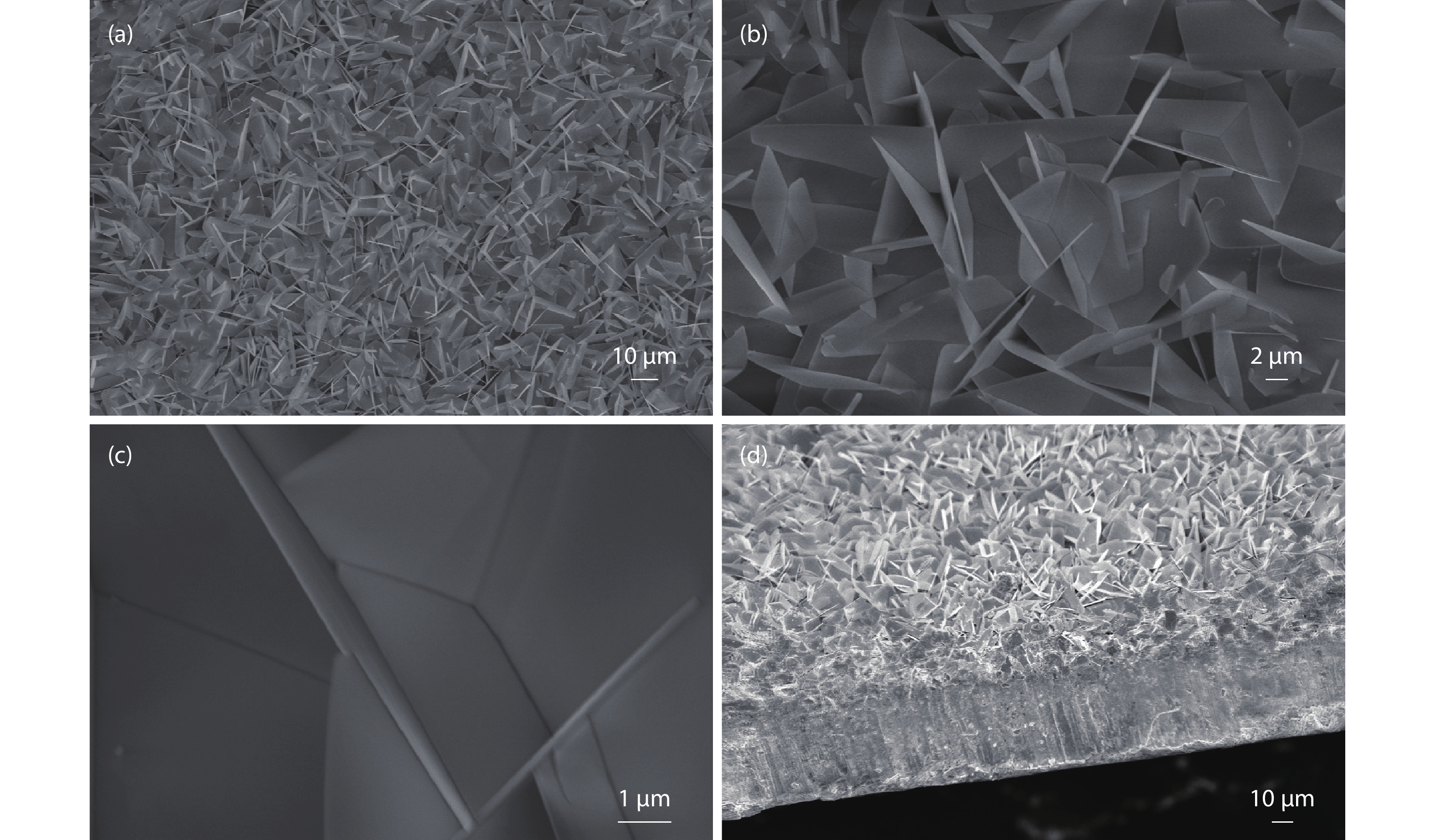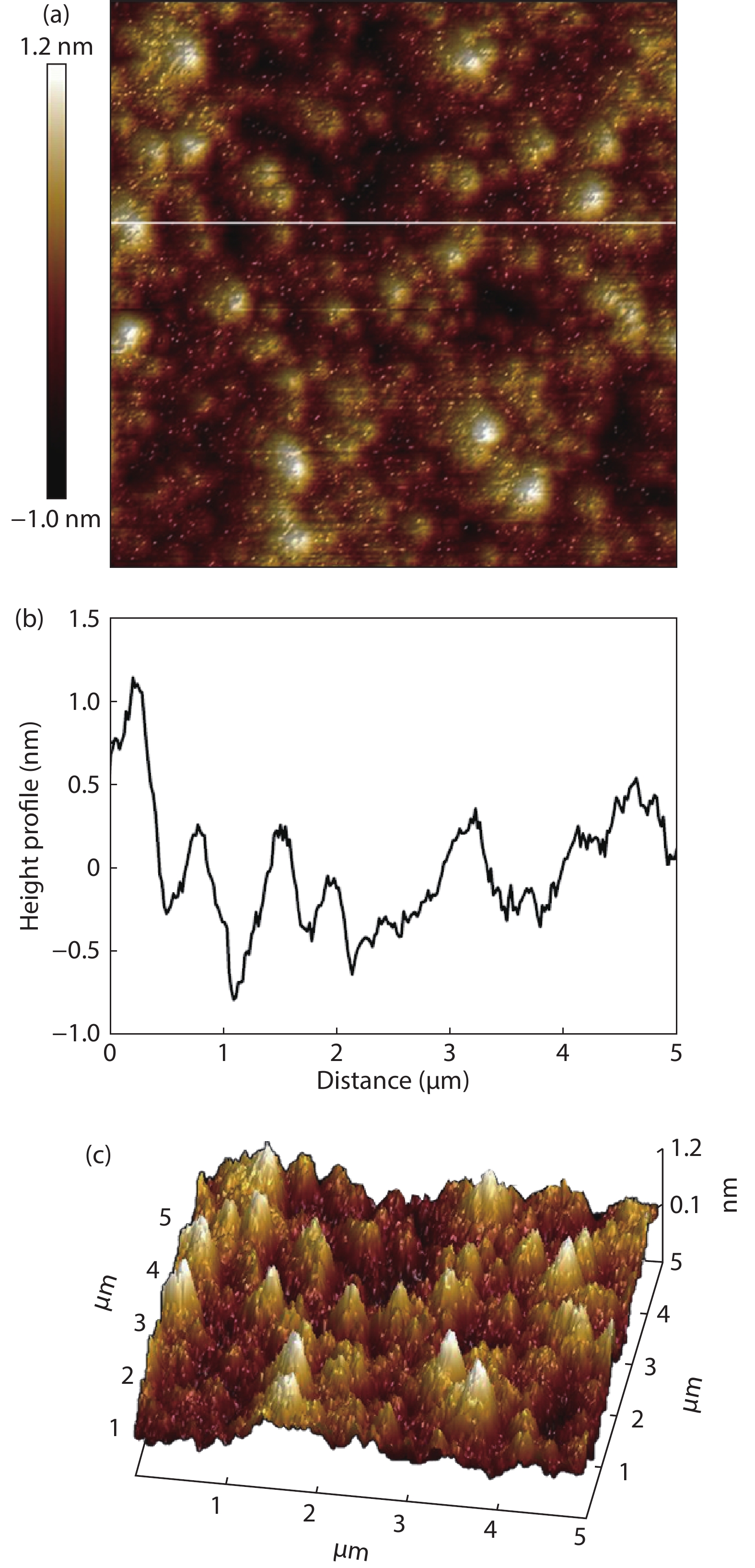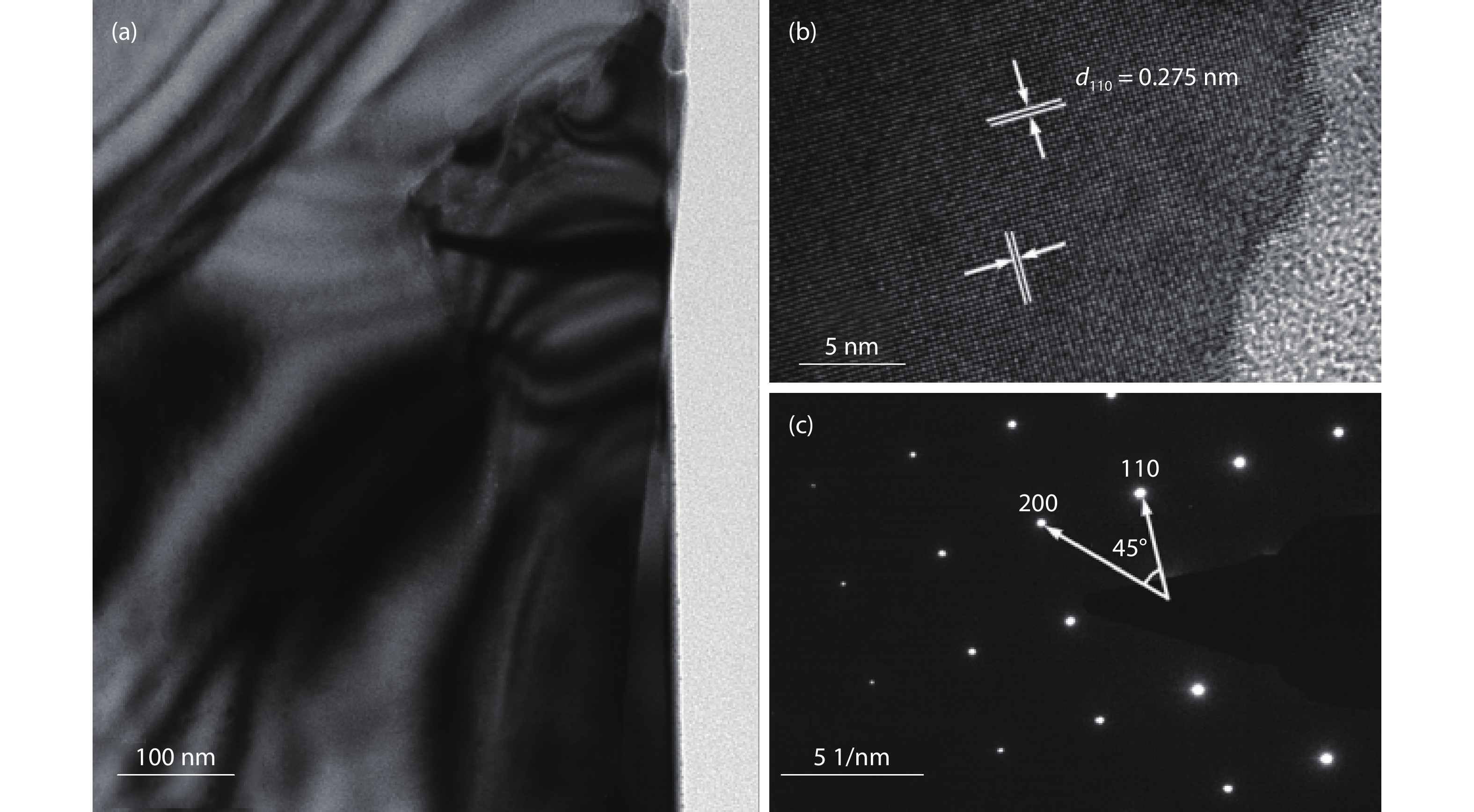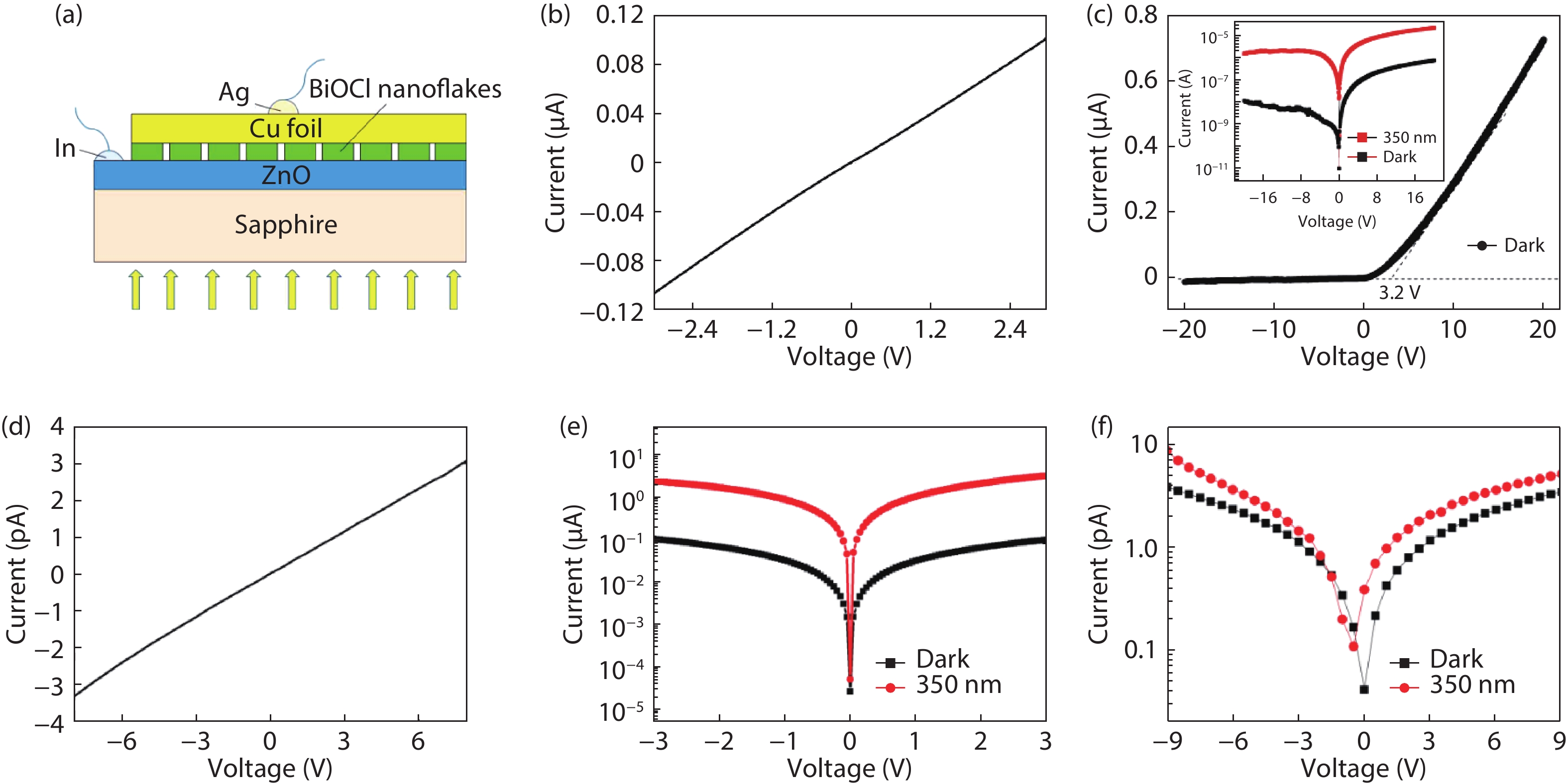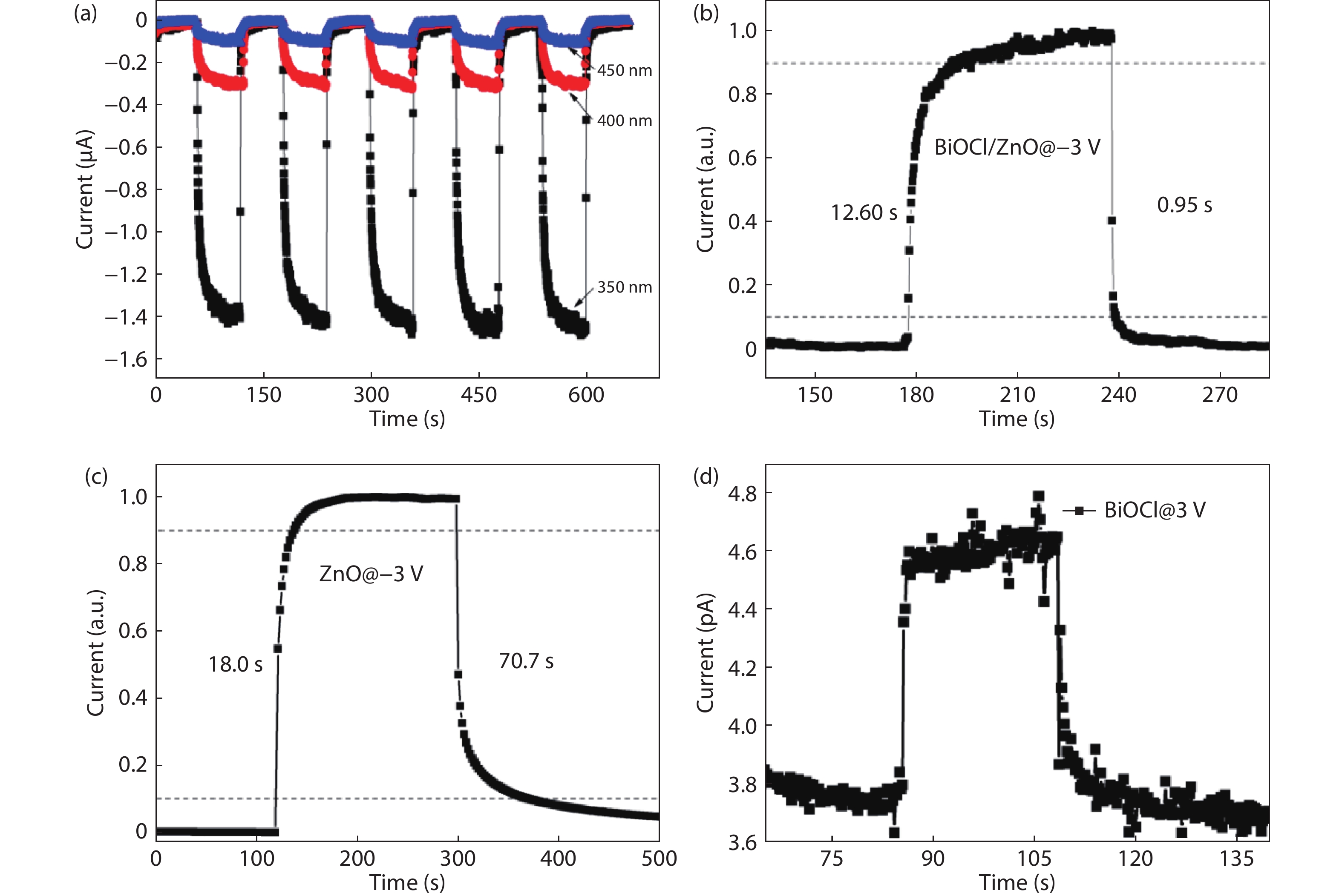| Citation: |
Longxing Su, Weixin Ouyang, Xiaosheng Fang. Facile fabrication of heterostructure with p-BiOCl nanoflakes and n-ZnO thin film for UV photodetectors[J]. Journal of Semiconductors, 2021, 42(5): 052301. doi: 10.1088/1674-4926/42/5/052301
****
L X Su, W X Ouyang, X S Fang, Facile fabrication of heterostructure with p-BiOCl nanoflakes and n-ZnO thin film for UV photodetectors[J]. J. Semicond., 2021, 42(5): 052301. doi: 10.1088/1674-4926/42/5/052301.
|
Facile fabrication of heterostructure with p-BiOCl nanoflakes and n-ZnO thin film for UV photodetectors
DOI: 10.1088/1674-4926/42/5/052301
More Information
-
Abstract
Herein, high-quality n-ZnO film layer on c-sapphire and well-crystallized tetragonal p-BiOCl nanoflakes on Cu foil are prepared, respectively. According to the absorption spectra, the bandgaps of n-ZnO and p-BiOCl are confirmed as ~3.3 and ~3.5 eV, respectively. Subsequently, a p-BiOCl/n-ZnO heterostructural photodetector is constructed after a facile mechanical bonding and post annealing process. At –5 V bias, the photocurrent of the device under 350 nm irradiation is ~800 times higher than that in dark, which indicates its strong UV light response characteristic. However, the on/off ratio of In–ZnO–In photodetector is ~20 and the Cu–BiOCl–Cu photodetector depicts very weak UV light response. The heterostructure device also shows a short decay time of 0.95 s, which is much shorter than those of the devices fabricated from pure ZnO thin film and BiOCl nanoflakes. The p-BiOCl/n-ZnO heterojunction photodetector provides a promising pathway to multifunctional UV photodetectors with fast response, high signal-to-noise ratio, and high selectivity.-
Keywords:
- ZnO thin film,
- BiOCl nanoflakes,
- heterostucture,
- UV photodetector
-
References
[1] Chen H Y, Liu K W, Hu L F, et al. New concept ultraviolet photodetectors. Mater Today, 2015, 18(9), 493 doi: 10.1016/j.mattod.2015.06.001[2] Lou Z, Yang X L, Chen H R, et al. Flexible ultraviolet photodetectors based on ZnO-SnO2 heterojunction nanowire arrays. J Semicond, 2018, 39(2), 024002 doi: 10.1088/1674-4926/39/2/024002[3] Su L X, Yang W, Cai J, et al. Self-powered ultraviolet photodetectors driven by built-in electric field. Small, 2017, 13(45), 1701687 doi: 10.1002/smll.201701687[4] Xu X J, Chen J X, Cai S, et al. A real-time wearable UV-radiation monitor based on a high-performance p-CuZnS/n-TiO2 photodetector. Adv Mater, 2018, 30(43), 1803165 doi: 10.1002/adma.201803165[5] Sang L W, Liao M Y, Sumiya M. A comprehensive review of semiconductor ultraviolet photodetectors: from thin film to one-dimensional nanostructures. Sensors, 2013, 13(8), 10482 doi: 10.3390/s130810482[6] Li SY, Zhang Y, Yang W, et al. 2D perovskite Sr2Nb3O10 for high-performance UV photodetectors. Adv Mater, 2020, 32(7), 1905443 doi: 10.1002/adma.201905443[7] Konstantatos G, Levina, L, Fischer A, et al. Engineering the temporal response of photoconductive photodetectors via selective introduction of surface trap states. Nano Lett, 2008, 8(5), 1446 doi: 10.1021/nl080373e[8] Jin Y Z, Wang J P, Sun B Q, et al. Solution-processed ultraviolet photodetectors based on colloidal ZnO nanoparticles. Nano Lett, 2008, 8(6), 1649 doi: 10.1021/nl0803702[9] Zhao B, Wang F, Chen H Y, et al. An ultrahigh responsivity (9.7 mA W–1) self-powered solar-blind photodetector based on individual ZnO-Ga2O3 heterostructures. Adv Funct Mater, 2017, 27(17), 1700264 doi: 10.1002/adfm.201700264[10] Kong W Y, Wu G A, Wang K Y, et al. Graphene-β-Ga2O3 heterojunction for highly sensitive deep UV photodetector application. Adv Mater, 2016, 28(48), 10725 doi: 10.1002/adma.201604049[11] Chen X M, Liu K W, Zhang Z Z, et al. A self-powered solar-blind photodetector with fast response based on Au/β-Ga2O3 nanowires array film Schottky junction. ACS Appl Mater Inter, 2016, 8(6), 4185 doi: 10.1021/acsami.5b11956[12] Pratiyush A S, Krishnamoorthy S, Solanke S V, et al. High responsivity in molecular beam epitaxy grown β-Ga2O3 metal semiconductor metal solar blind deep-UV photodetector. Appl Phys Lett, 2017, 110(22), 221107 doi: 10.1063/1.4984904[13] Posada F G, Songmuang R, Hertog M D, et al. Room-temperature photodetection dynamics of single GaN nanowires. Nano Lett, 2012, 12(1), 172 doi: 10.1021/nl2032684[14] Butuna B, Tut T, Ulker E, et al. High-performance visible-blind GaN-based p–i–n photodetectors. Appl Phys Lett, 2008, 92(3), 033507 doi: 10.1063/1.2837645[15] Xu G Y, Salvador A, Kim W, et al. High speed, low noise ultraviolet photodetectors based on GaN p–i–n and AlGaN(p)-GaN(i)-GaN(n) structures. Appl Phys Lett, 1997, 71(15), 2154 doi: 10.1063/1.119366[16] Zheng L X, Yu P P, Hu K, et al. Scalable-production, self-powered TiO2 nanowell-organic hybrid UV photodetectors with tunable performances. ACS Appl Mater Inter, 2016, 8(49), 33924 doi: 10.1021/acsami.6b11012[17] Li X D, Gao C T, Duan H G, et al. Nanocrystalline TiO2 film based photoelectrochemical cell as self-powered UV-photodetector. Nano Energy, 2012, 1(4), 640 doi: 10.1016/j.nanoen.2012.05.003[18] Patel M, Kim H S, Kim J. All transparent metal oxide ultraviolet photodetector. Adv Electron Mater, 2015, 1(11), 1500232 doi: 10.1002/aelm.201500232[19] Chen Z, Li B R, Mo X M, et al. Self-powered narrowband p-NiO/n-ZnO nanowire ultraviolet photodetector with interface modification of Al2O3. Appl Phys Lett, 2017, 110(12), 123504 doi: 10.1063/1.4978765[20] Cai J, Xu X J, Su L X, et al. Self-powered n-SnO2/p-CuZnS core-shell microwire UV photodetector with optimized performance. Adv Opt Mater, 2018, 6(15), 1800213 doi: 10.1002/adom.201800213[21] Xu X J, Shukla S, Liu Y, et al. Solution-processed transparent self-powered p-CuS-ZnS/n-ZnO UV Photodiode. Phys Status Solidi RRL, 2018, 12(2), 1700381 doi: 10.1002/pssr.201700381[22] Su L X, Zhang Q L, Wu T Z, et al. High-performance zero-bias ultraviolet photodetector based on p-GaN/n-ZnO heterojunction. Appl Phys Lett, 2014, 105(7), 072106 doi: 10.1063/1.4893591[23] Su L X, Zhu Y, Yong D Y, et al. Wide range bandgap modulation based on ZnO-based alloys and fabrication of solar blind UV detectors with high rejection ratio. ACS Appl Mater Inter, 2014, 6(16), 14152 doi: 10.1021/am503427u[24] Moon T H, Jeong M C, Lee W, et al. The fabrication and characterization of ZnO UV detector. Appl Surf Sci, 2005, 240(1–4), 280 doi: 10.1016/j.apsusc.2004.06.149[25] Wang Z N, Yu R M, Wang X F, et al. Ultrafast response p-Si/n-ZnO heterojunction ultraviolet detector based on pyro-phototronic effect. Adv Mater, 2016, 28(32), 6880 doi: 10.1002/adma.201600884[26] Liang S, Sheng H, Liu Y, et al. ZnO Schottky ultraviolet photodetectors. J Cryst Growth, 2001, 225(2–5), 110 doi: 10.1016/S0022-0248(01)00830-2[27] Pearton S J, Norton D P, Ip K, et al. Recent progress in processing and properties of ZnO. Prog Mater Sci, 2005, 50(3), 293 doi: 10.1016/j.pmatsci.2004.04.001[28] Özgüra Ü, Alivov Y I, Liu C, et al. A comprehensive review of ZnO and related devices. J Appl Phys, 2005, 98(4), 041301 doi: 10.1063/1.1992666[29] Shen H, Shan C, Li B, et al. Reliable self-powered highly spectrum-selective ZnO ultraviolet photodetectors. Appl Phys Lett, 2013, 103, 232112 doi: 10.1063/1.4839495[30] Cho H D, Zakirov A S, Yuldashev S U, et al. Photovoltaic device on a single ZnO nanowire p –n homojunction. Nanotechnology, 2012, 23(11), 115401 doi: 10.1088/0957-4484/23/11/115401[31] Hu K, Teng F, Zheng L X, et al. Binary response Se/ZnO p–n heterojunction UV photodetectorrnwith high on/off ratio and fast speed. Laser Photonics Rev, 2017, 11(1), 1600257 doi: 10.1002/lpor.201600257[32] Chen H Y, Yu P P, Zhang Z M, et al. Ultrasensitive self-powered solar-blind deep-ultraviolet photodetector based on all-solid-state polyaniline/MgZnO bilayer. Small, 2016, 12(42), 5809 doi: 10.1002/smll.201601913[33] Li J, Li H, Zhan G, et al. Solar water splitting and nitrogen fixation with layered bismuth oxyhalides. Acc Chem Res, 2017, 50(1), 112 doi: 10.1021/acs.accounts.6b00523[34] Huang X Y, Li B, Guo H. Synthesis, photoluminescence, cathodoluminescence and thermal properties of novel Tb3+-doped BiOCl green-emitting phosphors. J Alloy Compd, 2017, 695(25), 2773 doi: 10.1016/j.jallcom.2016.11.224[35] Zhang Y W, Xu X H, Xing Y, et al. Growth and electronic transport property of layered BiOCl microplates. Adv Mater Interfaces, 2015, 2(12), 1500194 doi: 10.1002/admi.201500194[36] Dutta S, Das T, Datta S. Impact of bi-axial strain on structural, electronic and optical properties of photo-catalytic bulk bismuth oxy-halides. Phys Chem Chem Phys, 2018, 20(1), 103 doi: 10.1039/C7CP07366F[37] Dash A, Sarkar S, Adusumalli V N K B, et al. Microwave synthesis, photoluminescence, and photocatalytic activity of PVA-functionalized Eu3+ -doped BiOX (X = Cl, Br, I) nanoflakes. Langmuir, 2014, 30(5), 1401 doi: 10.1021/la403996m[38] Li Y J, Wang Q, Liu B C, et al. The {001} facets-dependent superior photocatalytic activities of BiOCl nanosheets under visible light irradiation. Appl Surf Sci, 2015, 349(15), 957 doi: 10.1016/j.apsusc.2015.05.100[39] Tripathi G K, Kurchania R. Photocatalytic behavior of BiOX (X = Cl/Br, Cl/I and Br/I) composites/heterogeneous nanostructures with organic dye. Opt Quant Electron, 2017, 49(6), 203 doi: 10.1007/s11082-017-1042-3[40] Cheng H F, Huang B B, Dai Y. Engineering BiOX (X = Cl, Br, I) nanostructures for highly efficient photocatalytic applications. Nanoscale, 2014, 6(4), 2009 doi: 10.1039/c3nr05529a[41] Yu Y X, Ouyang W X, Zhang W D. Photoelectrochemical property of the BiOBr-BiOI/ZnO heterostructures with tunable bandgap. J Solid State Electrochem, 2014, 18(6), 1743 doi: 10.1007/s10008-014-2402-6[42] Teng F, Ouyang W X, Li Y M, et al. Novel structure for high performance UV photodetector based on BiOCl/ZnO hybrid film. Small, 2017, 13(22), 1700156 doi: 10.1002/smll.201700156 -
Supplements
 20090013supp.pdf
20090013supp.pdf

-
Proportional views





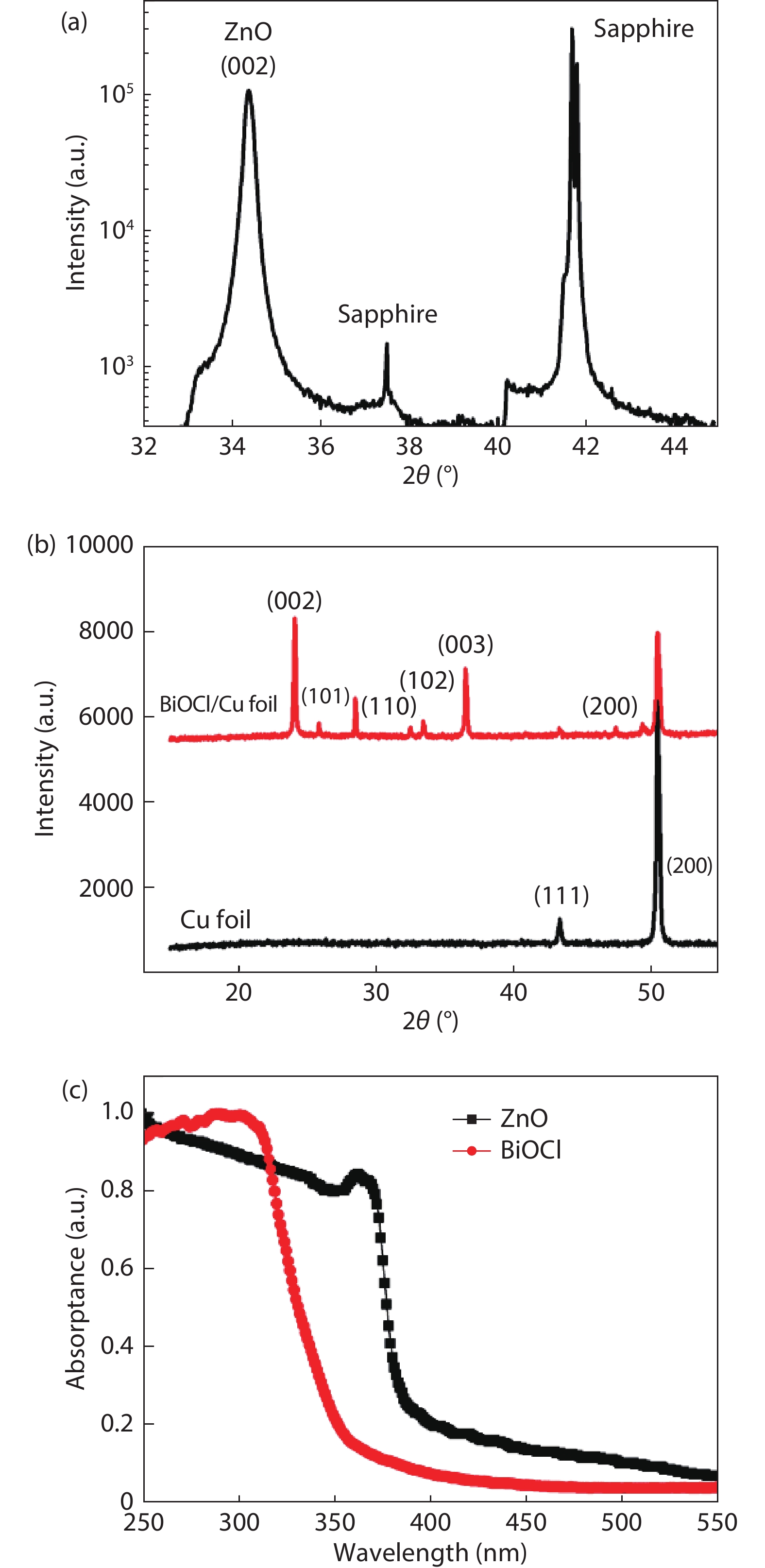
 DownLoad:
DownLoad:
